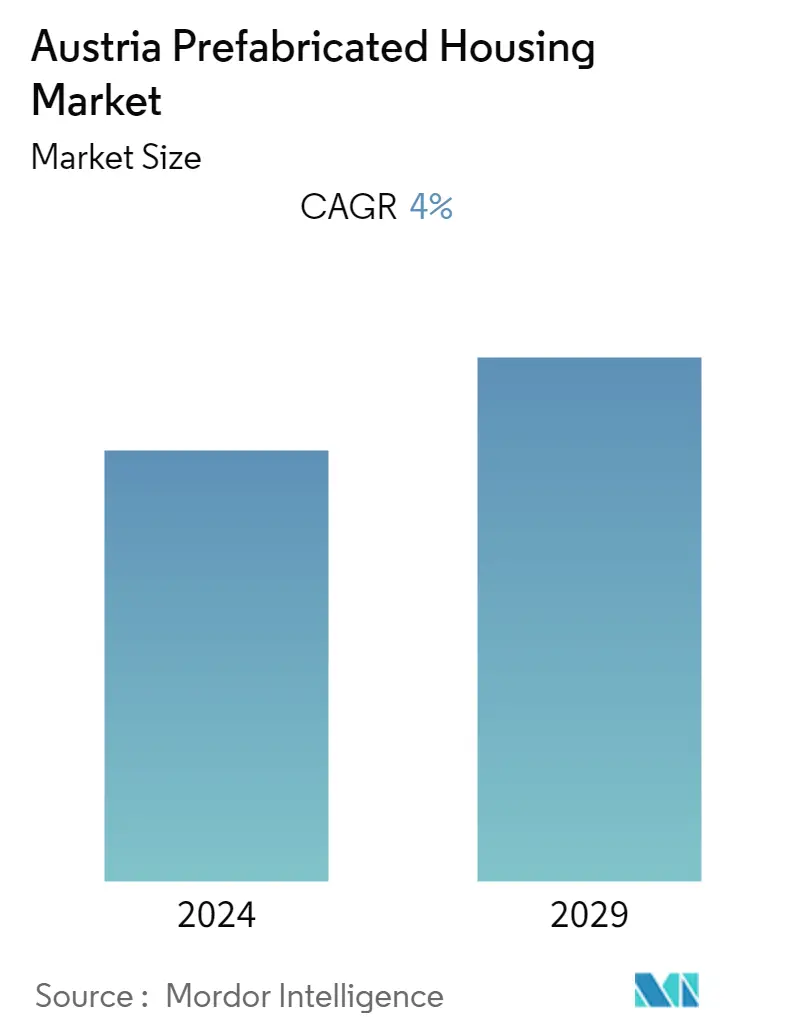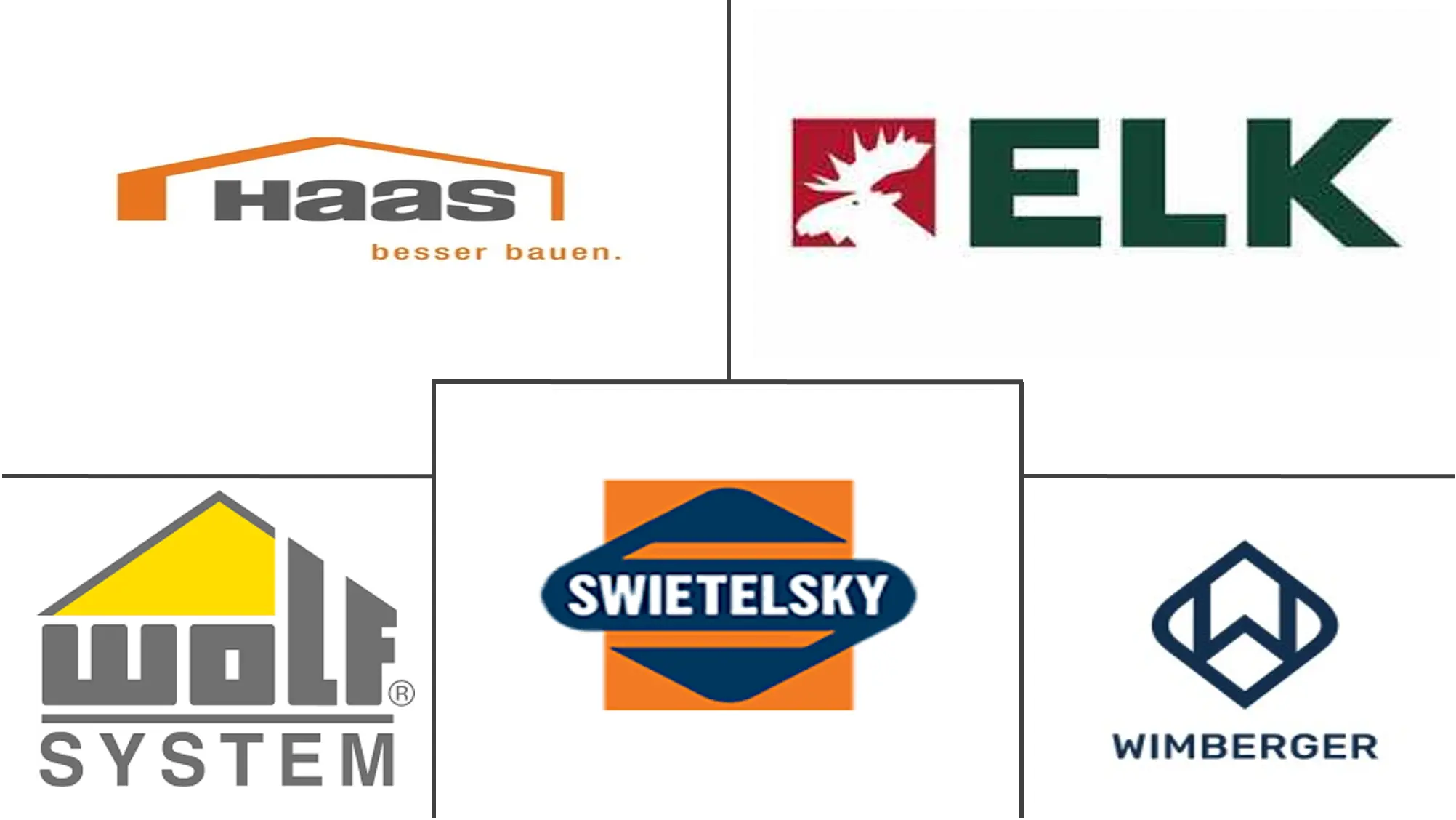Market Size of Austria Prefabricated Housing Industry

| Study Period | 2019 - 2029 |
| Base Year For Estimation | 2023 |
| Forecast Data Period | 2024 - 2029 |
| Historical Data Period | 2019 - 2022 |
| CAGR | 4.00 % |
| Market Concentration | Medium |
Major Players
*Disclaimer: Major Players sorted in no particular order |
Austria Prefabricated Housing Market Analysis
During the forecast period, the Austrian prefabricated housing market is expected to register a CAGR of about 4%.
- The demand for low- to mid-rise residential structures, project homes, and public housing drives the market. Austria's prefabricated home market is expanding as consumers place more importance on turnkey solutions that meet all of today's requirements. Prefabricated housing is expanding steadily in Austria as the emphasis on turnkey solutions grows.
- An improving economy and rising demand for affordable housing solutions have been the main drivers of Austria's prefabricated housing market's robust growth over the past few years.The market has been focused on modernizing its housing sector, increasing the availability of off-site-built structures, and raising awareness about the advantages of prefabricated housing. Additionally, the government has been actively involved in promoting sustainable construction and has provided tax incentives for developers who opt for prefabricated housing. The market is further boosted by the growing interest from investors, particularly from China and other countries looking to set up production plants. Furthermore, the emergence of fully automated building systems and modular homes has gained traction in the market. The overall outlook for Austria's prefabricated housing market over the next few years remains positive, and the country's robust tourism industry is expected to be a long-term driver of growth.
- The impact of the COVID-19 pandemic on Austria's prefabricated housing market was varied. The suspension of construction projects and limitations on building materials due to social-distancing measures affected the sector to a certain extent. As a result, some suppliers saw their order books drop or suffer from delivery delays. On the other hand, the demand for prefabricated housing projects kept increasing, as these could be completed more rapidly in comparison to traditionally built projects and increase the social versatility of housing in urban areas. Furthermore, the affordability factor of prefabricated housing makes it an attractive housing solution for those looking to purchase their own homes.
Austria Prefabricated Housing Industry Segmentation
Most prefabricated homes, which are also called "prefab" homes, are made off-site before they are shipped and put together on-site.This study gives information about the market, such as its dynamics, drivers, restraints, and opportunities. It also talks about how COVID-19 affected the market and how technological innovation will affect the market.The research also includes company profiles to help readers understand the market's competitive environment.
The Austrian prefabricated housing market is segmented by type (single family and multifamily). The report offers market size and forecasts for Austria's prefabricated housing market in terms of value (USD million) for all the above segments.
| By Type | |
| Single Family | |
| Multi Family |
Austria Prefabricated Housing Market Size Summary
The Austrian prefabricated housing market is experiencing steady growth, driven by an increasing demand for low- to mid-rise residential structures and public housing. The market is expanding as consumers increasingly seek turnkey solutions that fulfill modern requirements. The focus on modernizing the housing sector, enhancing the availability of off-site-built structures, and raising awareness about the benefits of prefabricated housing has been pivotal. Government initiatives promoting sustainable construction, along with tax incentives for developers, have further bolstered the market. The interest from international investors, particularly from China, and the rise of fully automated building systems and modular homes are additional factors contributing to the market's positive outlook. Despite challenges posed by the COVID-19 pandemic, such as project suspensions and material delivery delays, the demand for prefabricated housing has remained robust due to its quicker completion times and affordability.
The market for prefabricated housing in Austria is characterized by significant competition, with no single company dominating the landscape. This fragmentation has spurred innovation, leading to the development of new products like turnkey solutions and lightweight ceramic homes. Major players in the market, such as Swietelsky AG, Wolf Holding GmbH, and ELK Fertighaus GmbH, are focusing on enhancing performance and productivity through modular construction approaches. The government's commitment to addressing housing market challenges through increased construction, with prefabrication playing a crucial role, underscores the market's growth potential. The market's expansion is further supported by the country's strong tourism industry, which is expected to be a long-term growth driver.
Austria Prefabricated Housing Market Size - Table of Contents
-
1. MARKET INSIGHTS
-
1.1 Current Market Scenario
-
1.2 Technological Trends
-
1.3 Insights on Supply Chain/Value Chain Analysis of the Prefabricated Housing Industry
-
1.4 Cost Structure Analysis of the Prefabricated Housing Industry
-
1.5 Insights on Different Types of Materials used in Prefabricated Housing Construction
-
1.6 Impact of COVID-19 on the Market
-
-
2. MARKET SEGMENTATION
-
2.1 By Type
-
2.1.1 Single Family
-
2.1.2 Multi Family
-
-
Austria Prefabricated Housing Market Size FAQs
What is the current Austria Prefabricated Housing Market size?
The Austria Prefabricated Housing Market is projected to register a CAGR of 4% during the forecast period (2024-2029)
Who are the key players in Austria Prefabricated Housing Market?
Swietelsky AG, ELK Fertighaus GmbH, Wimberger Holding GmbH, Kieninger Gesellschaft and Georg Fessl GmbH are the major companies operating in the Austria Prefabricated Housing Market.

